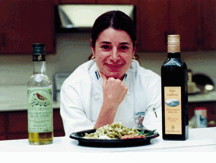|
Related Articles:
Dove
season |Star
struck | The
Hollywood pitch

Nutrition
and Dietetics Green Chair
International
Olive Oil Council member Connie Peraglie Guttersen '86, the Green Honors
Chair for nutrition and dietetics, says what is needed at the nation's
dinner tables is an ethnic cuisine led by the olive itself

Olive toil
by David Van Meter

 It
was the goddess Athena who brought the olive to the Greeks, the mythology
goes. It
was the goddess Athena who brought the olive to the Greeks, the mythology
goes.
Zeus promised to give all of Attica to
the god or goddess who made the most useful invention.
Beating out Poseidon's nifty war horse,
Athena planted the world's first olive tree on the rocky soil of the Acropolis,
producing a fruit that can be used for heat, light, medicine -- and for
incredibly healthy food.
This lore is not lost on Connie Peraglie
Guttersen '86, in her fifth year as dietitian for the Culinary Institute
of America. Neither did the petite, fit PhD allow the olive's nutritional
value to escape TCU's nutrition and dietetics students.
For one rainy week in February, the mantra
of the former TCU faculty member and visiting Green chair was Mediterranean
cuisine, a diet heavy on fruits and vegetables, light on meat, and where
more often than not, olive oil is a key ingredient.
"We're not trying to drastically
change the eating habits of the American consumer, but to start a good,
steady course toward healthier options," Guttersen told students.
"And you do that by offering more variety, which comes from ethnic
cuisine."
While rock-salt salmon -- a nine-pound
fish encased in a hardened shell of rock salt and egg whites -- cooked
in a nearby convection oven, Guttersen prepared dishes illustrating how
the Mediterranean region, though 40 percent of its diet comes from fat,
enjoys better health and lower levels of obesity than Americans: pasta
and a basil pesto sauce using extra virgin olive oil instead of, perhaps,
margarine or butter; a cucumber dip with olive oil and strained yogurt
instead of cream cheese; and a spicy romesco cracker dip rich with olive
oil as well as tomatoes, bell peppers, chiles and Italian bread.
Food management junior Shawnie Smith was
among those surprised at the flavors that passed around the Bass 309 classroom.
"I realized how many things you can
do with an olive and how flavorful it is. It's a powerful flavor and different
olives have different flavors," she said. "I had a bad view
of the olive, even though I knew it was a healthy fat, because it is so
high in fat. But I was really surprised at how good it is for us."
And that was Guttersen's take-home lesson
exactly. "The reason the Mediterranean population consumes so many
vegetables and beans and grains is that they cook with olive oil, and
this adds flavor," Guttersen said. "They never steam vegetables
with the fat-free vinaigrette.
"If we stay with a typical American
cuisine, where do we get a chance to incorporate more vegetables?"
Guttersen asked. "Our big three
are green beans, carrots and broccoli.
"You can achieve flavor by herbs and
spices and cooking techniques, rather than rely primarily on fat, salt
and sugar to achieve flavor. Once we start experiencing the Mediterranean
flavors of olive oil, cumin, coriander, saffron and paprika, we find that
they are exciting and delicious.
"We have to teach the consumer about
flavor and where to find it."
Americans, she said, can lower their weight
-- and expand their food choices -- by using more monounsaturated fats
such as nuts and avocados, eating fewer processed foods and watching portion
sizes.
"Already, we're seeing that restaurants
and food professionals are offering consumers more choices, and they include
healthier foods that are also delicious," she said. "We know
they're not going to take baby back ribs off the menu; those are good
sellers. But we're giving them ideas for foods from ethnic cultures that
are just as delicious.
"We don't teach diet plates, because
no one wants to eat that. We're providing foods that are healthy but just
as flavorful and exciting to experience."
Top
|



